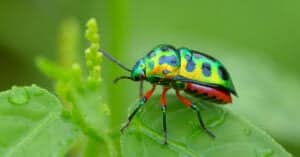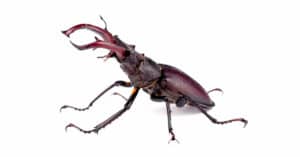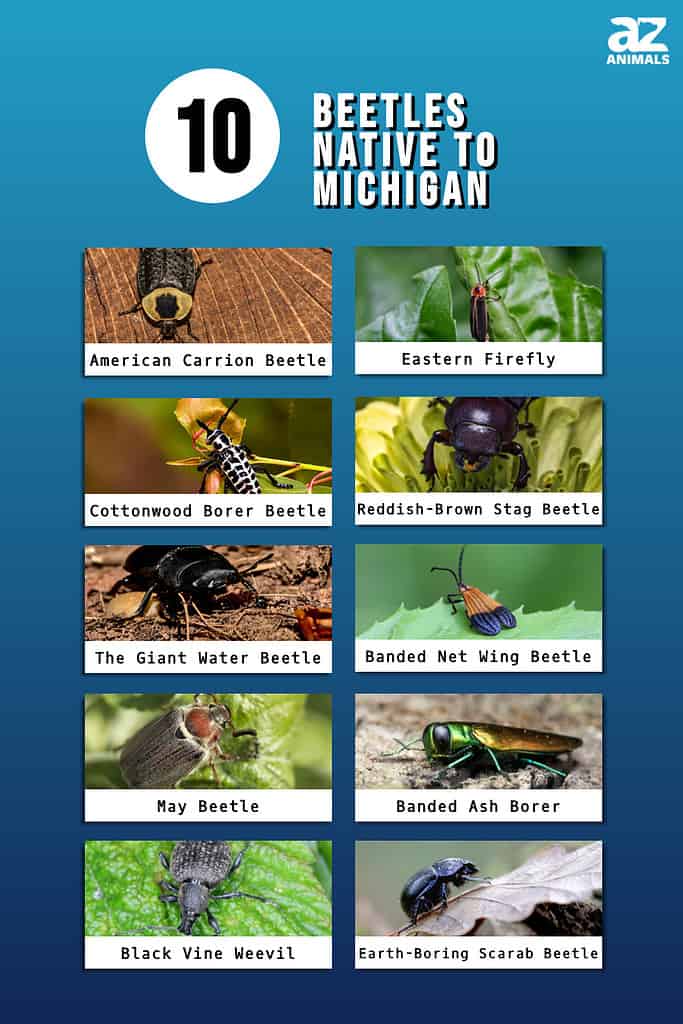
There are around 180 different species of beetles native to Michigan. It’s not the most beetles of any state, but it’s pretty good nonetheless. Since beetles make up 40% of all the known insects in the world, they’re easy to find just about anywhere you decide to travel.
As a whole, the United States has around 30,000 species of beetles. Nothing else in the insect world comes close. You have to get into mammals to find comparable or overwhelming numbers. The term “native” is an important one to understand. It doesn’t mean the same thing as indigenous.
Native to Michigan means the beetles are either indigenous to Michigan or the species arrived there by any means outside of humans. For instance, if birds accidentally transferred a species of beetle eggs to Michigan 500 years ago, the beetles from those eggs would be native to Michigan later.
Black Beetles in Michigan
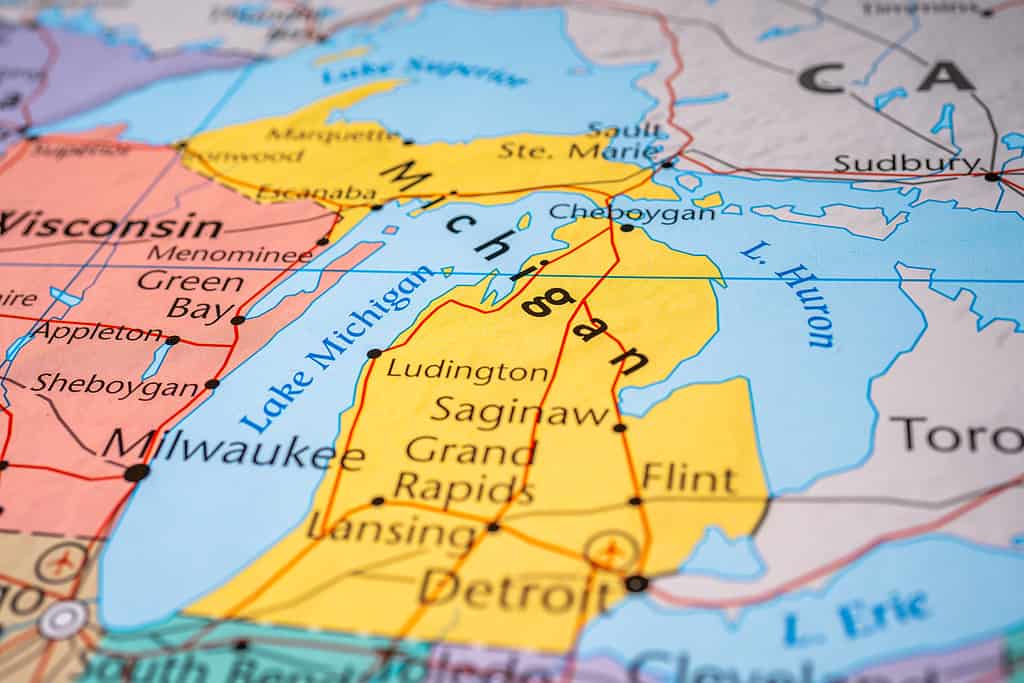
There are around 180 different species of beetles native to Michigan.
©Alexander Lukatskiy/Shutterstock.com
There are a lot of black beetles in Michigan. Some of the more interesting ones include the black carpet beetle, the margined blister beetle, and the big-headed ground beetle. Black beetles are fairly common in Michigan and the United States.
While there are a lot of black beetles that aren’t black beetles, there are also multi-colored beetles that fall under the black beetle umbrella. That’s because the term “black beetle” is a category rather than a description.
The pigweed flea beetle is a prime example. While it does have black colorations, its appearance is dominated by a bright, red head area and large, white stripes that travel vertically down its wings. However, despite that description, the pigweed flea beetle is black.
Another example, even weirder than the pigweed flea beetle, is the cucumber beetle, which is barely black at all. The cucumber beetle is a bright, vivacious yellow with glossy, sometimes reflective overtones. The only black on the cucumber beetle is a series of small, black dots or stripes—dots/stripes that resemble the patterning on a ladybug.
Large Beetles in Michigan
Michigan is home to the largest beetle in the world, otherwise known as the eastern Hercules beetle or just the Hercules beetle. This beetle is mostly tan but also features a series of black, random patterns on its wings. It’s an enormous beetle, with the males often reaching seven inches long. The females aren’t much smaller, either.
Michigan is also home to the stag beetle, which isn’t as large as its giant stag beetle cousin. However, it’s still one big bug, coming in at one and a half inches long. The giant water bug is also one of the largest beetles native to Michigan, although it’s rare to see one.
Giant water bugs are only second to the Hercules beetle. The male often grows to almost five inches in length and has a pair of powerful mandibles for grabbing and holding prey. While they resemble cockroaches, they are far rarer and much larger. As you can see, Michigan plays host to a large variety of beetles, and not all of them are huge or in the black beetle family.
1. American Carrion Beetle

Without carrion beetles and other insects that feed on decaying flesh, carcasses would take too long to decay in the wild.
©Jay Ondreicka/Shutterstock.com
This beetle looks like it belongs in a deck of playing cards, specifically the clubs. Its large, white thorax surrounds a dead black center that resembles a club. Though the abdomen and head are black, the thorax’s contrasting black and clean white stand out.
As its name suggests, the American carrion beetle fondly feeds on carrion. The females will smell a dead carcass from miles away and make their way to it, especially if she’s ready to lay eggs. Once the eggs hatch, the larvae join the feast, facilitating the decaying process.
While not the most cleanly beetle in the world, the American carrion beetle plays a vital role in the cycle of life. Without carrion beetles and other insects that feed on decaying flesh, carcasses would take too long to decay in the wild.
2. Eastern Firefly

Eastern
fireflies
prefer marshes and heavily wooded areas.
©iStock.com/ErikAgar
Everybody loves fireflies, and the eastern firefly is much like fireflies everywhere, using its bioluminescence to light up the skies at dusk. They are most prevalent in the late spring, which is their breeding season. They only grow to about half an inch in length, but they light up the night quite well, even for their small size.
Eastern fireflies prefer marshes and heavily wooded areas. If you live somewhere close to a tree line, you will see them at night, hovering by the hundreds at the perimeter of the trees. The male and female eastern fireflies are dusky black with a cream-colored outline on their wings. They typically have redheads, reddish-orange, or orange.
Though their ability to light their bodies up is entertaining, there is more than a single purpose for it. The lights are the eastern firefly’s way to attract mates. It’s also a warning against predators. The bioluminescence is also a poison, which predators instinctively understand.
3. Cottonwood Borer Beetle
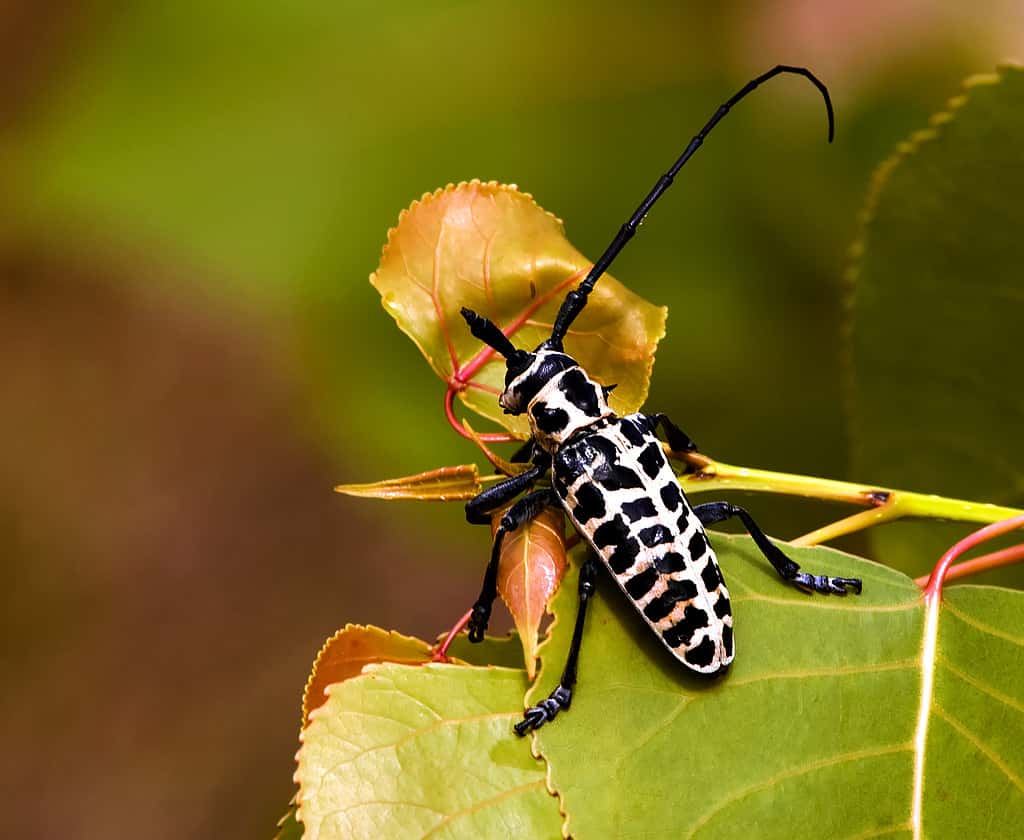
The cottonwood is like a checker or chess board, with a white background and black markings that resemble squares roughly drawn with a sharpie.
©iStock.com/Michael Clay Smith
The cottonwood borer beetle has an incredible aesthetic. Though it’s almost entirely black ad white, the juxtaposition of the two is eye-catching. The cottonwood is like a checker or chess board, with a white background and black markings that resemble squares roughly drawn with a sharpie.
When you have a cool color pattern like that, it’s even better if you stand out. Fortunately, the cottonwood beetle grows up to an inch and a half in length, which certainly stands out. They are mostly harmless and fairly docile. Like the eastern firefly, they prefer to live in marsh-like areas and deep in the forest.
They mostly eat trees, which means they are sometimes problematic, depending on how many congregate in a small area. The female will eat her way into the base of the tree before laying her eggs.
4. Reddish-Brown Stag Beetle

The stag beetle has extra large mandibles strong enough to grab and hold prey.
©John Reed Pavan/Shutterstock.com
The reddish-brown stag beetle is another of the largest beetles native to Michigan. Though mentioned above, the reddish-brown stag beetle is worth an extra mention. For one, it’s a large beetle, often reaching lengths of 1.5 inches.
It’s also unique because of its reddish-brown appearance, which separates it from other stag beetles. Like its cousins, the stag beetle has extra large mandibles strong enough to grab and hold prey and to wrestle with other stag beetles over breeding rights and territory.
Like other stag beetles, including the giant stag beetle, reddish-brown stag beetles prefer a diet of decaying trees and bark. They’ll occasionally munch on dead and soggy leaves as well.
5. The Giant Water Beetle

The male giant water beetle typically grows to 4.5 inches in length.
©Bartsch Photography/Shutterstock.com
Another one mentioned above is the giant water beetle. This bug is enormous and only second to the Hercules beetle in the battle for the largest beetle in the US. The male typically grows to 4.5 inches in length.
The giant water beetle uses its huge mandibles to grab prey floating by in the water. Once it has them, its mandibles will hold them in place while the giant water bug eats them alive. The mandibles of the giant water bug are much stronger than stag beetles or even giant stag beetles.
Giant water beetles resemble roaches, albeit much larger physically. Even the way the wings fold in has a distinct cockroach look to them.
6. Banded Net Wing Beetle

The banded net wing beetle prefers tropical environments, yet they get along just fine in Michigan.
©EM-80/Shutterstock.com
The banded net wing beetle is a unique-looking beetle that kind of resembles a firefly or a lovebug. The biggest difference is in its unique colors. The wings are mostly orange, with thick bands of black running horizontally across them.
Interestingly, the banded net wing beetle prefers tropical environments, yet they get along just fine in Michigan, where the climate is far from tropical. They have long, heavily segmented antennae thicker than most beetles’ antennae.
They’re also pretty good flyers, though they tend not to remain aloft for too long. When predators are near, the banded net wing releases a foul-smelling chemical to alert the predator that eating the beetle would be a horrible mistake.
7. May Beetle
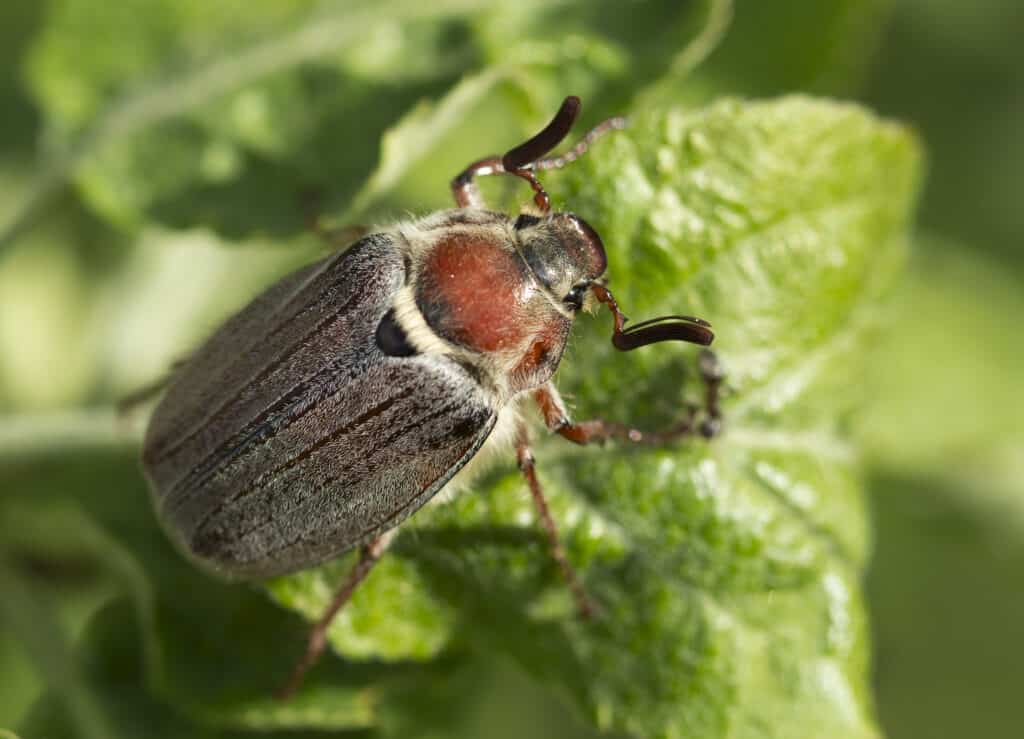
The May Beetle has a hefty and oblong body.
©Galina Savina/Shutterstock.com
The May Beetle has a very interesting look to it. The body is physically similar to that of the green June beetle, except the May beetle lacks metallic overtones. The may beetle resembles a piece of heavily polished furniture with deep bronze and wood grain patterns.
There is no variety of colors, with certain May beetles looking different from others. March through July are the primary months for spotting a May beetle as they go about looking for food and mates. Some of them can reach almost an inch in length, but most are around half of that.
8. Banded Ash Borer
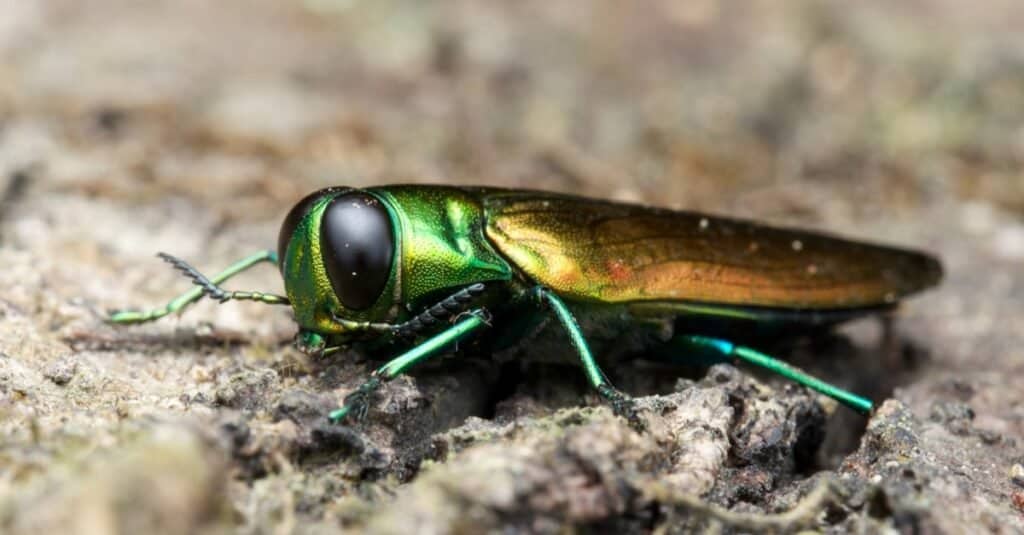
The Emerald Ash Borer, a type of beetle, kills ash trees by destroying the water and nutrient-conducting tissues under the tree’s bark.
©Herman Wong HM/Shutterstock.com
Another of the more unique beetles native to Michigan, the banded ash borer is a dusky black with a series of boxy, yellowish outline patterns running down its length. Where the thorax meets the head, a yellow ring resembles a tiny collar.
As the name suggests, the banded ash borer prefers ash trees as its host. However, they aren’t overly destructive like some beetles are. If it can find a dead or dying ash tree, the banded ash borer will choose it over any other.
Both the males and females bore into the wood. The male for mating purposes and the female for egg-laying. Once the eggs hatch, the larvae feed on the decaying portions of the tree until they reach their next stage of development.
9. Black Vine Weevil
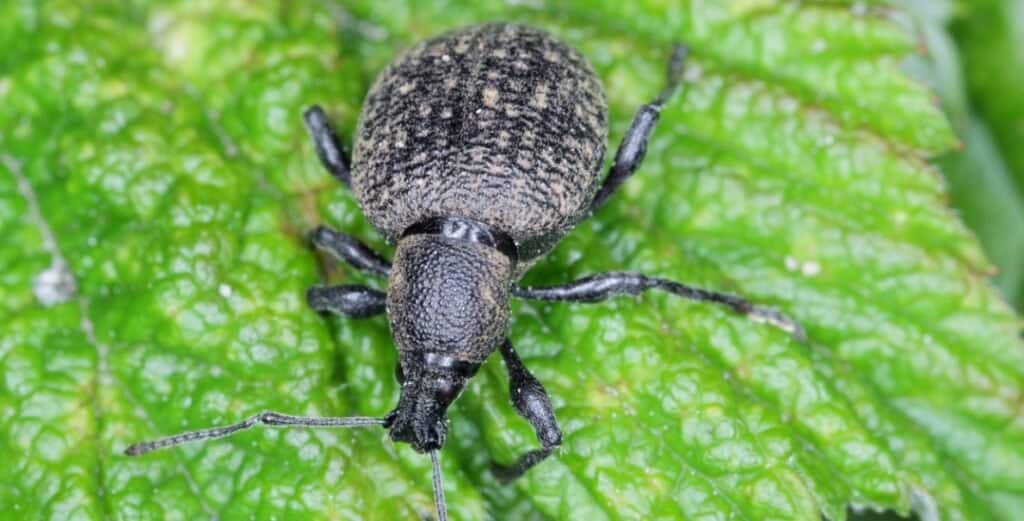
The
Otiorhynchusbeetle.
©iStock.com/Tomasz Klejdysz
The black vine weevil isn’t a beetle you see very often, mostly because it’s nocturnal. It mostly comes out at night, feeding throughout the twilight hours on a diet of leaves. The type of leaves it feeds on are pretty irrelevant, so long as it’s there, the black vine weevil will eat it.
Black vine weevils are even harder to see because they are all black, a physical trait that aids them against predators. If you want to find one of these hard-to-spot weevils, you’ll need a flashlight and plenty of patience.
Last but not least, they are very small, often only reaching about .1 inches in length. In terms of defense, the black vine weevil has darkness, a black body, and small size to keep it safe from predators and people.
10. Earth-Boring Scarab Beetle
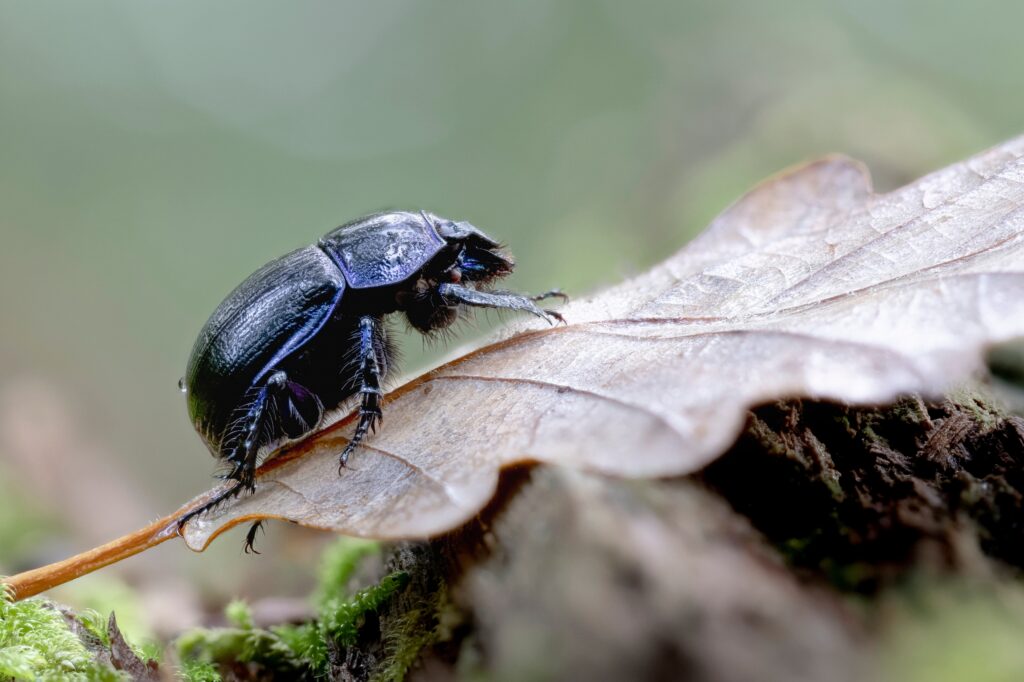
The female earth-boring scarab will dig up to nine feet into the earth and lay her eggs at the very bottom of the tunnel.
©DKeith/Shutterstock.com
The earth-boring scarab beetle is a very domelike beetle, with a large, bulging abdomen and thorax to match a tiny head. It has two tiny antennae with a large, bulbous protrusion on the end of each one. The beetle is typically orangish-red in color and slightly fuzzy.
The female earth-boring scarab will dig up to nine feet into the earth and lay her eggs at the very bottom of the tunnel. They also have a pretty diverse palette, with feces, fungi, leaves, compost, and various decaying materials finding a way to their dinner plates.
The female will stash portions of the above at the bottom of her long tunnel. When the larvae hatch, they’ll consume these materials on their way out of the hole.
Summary of the 10 Beetles Native to Michigan
Here is a list of the 10 beetles that are native to the state of Michigan:
| Rank | Beetle Species Native to Michigan |
|---|---|
| 1 | American Carrion Beetle |
| 2 | Eastern Firefly |
| 3 | Cottonwood Borer Beetle |
| 4 | Reddish-Brown Stag Beetle |
| 5 | The Giant Water Beetle |
| 6 | Banded Net Wing Beetle |
| 7 | May Beetle |
| 8 | Banded Ash Borer |
| 9 | Black Vine Weevil |
| 10 | Earth-Boring Scarab Beetle |
Final Thoughts
There are roughly 180 beetles native to Michigan, and most of them are fairly innocuous, minding their own business and going about their day. In the case of some, like the black vine weevil, going about their night is a more accurate statement.
Michigan beetles have a variety of environments to take advantage of, including the Great Lakes, plateaus, and plains. The variety of ecoregions is enough to accommodate a diverse population of beetles, and Michigan is an excellent state to find giant beetles, tiny beetles, and some of the more unique beetles in the region.
The photo featured at the top of this post is © iStock.com/Michael Clay Smith
Thank you for reading! Have some feedback for us? Contact the AZ Animals editorial team.



